Environment-enemy PoP and river clay shaadu now face strong contender in mitti or farm soil as raw material for Ganesh idols. A third-generation potter and his doctor buddy are behind a one-of-a-kind experiment which, with government support can change the Ganesh visarjan pollution game
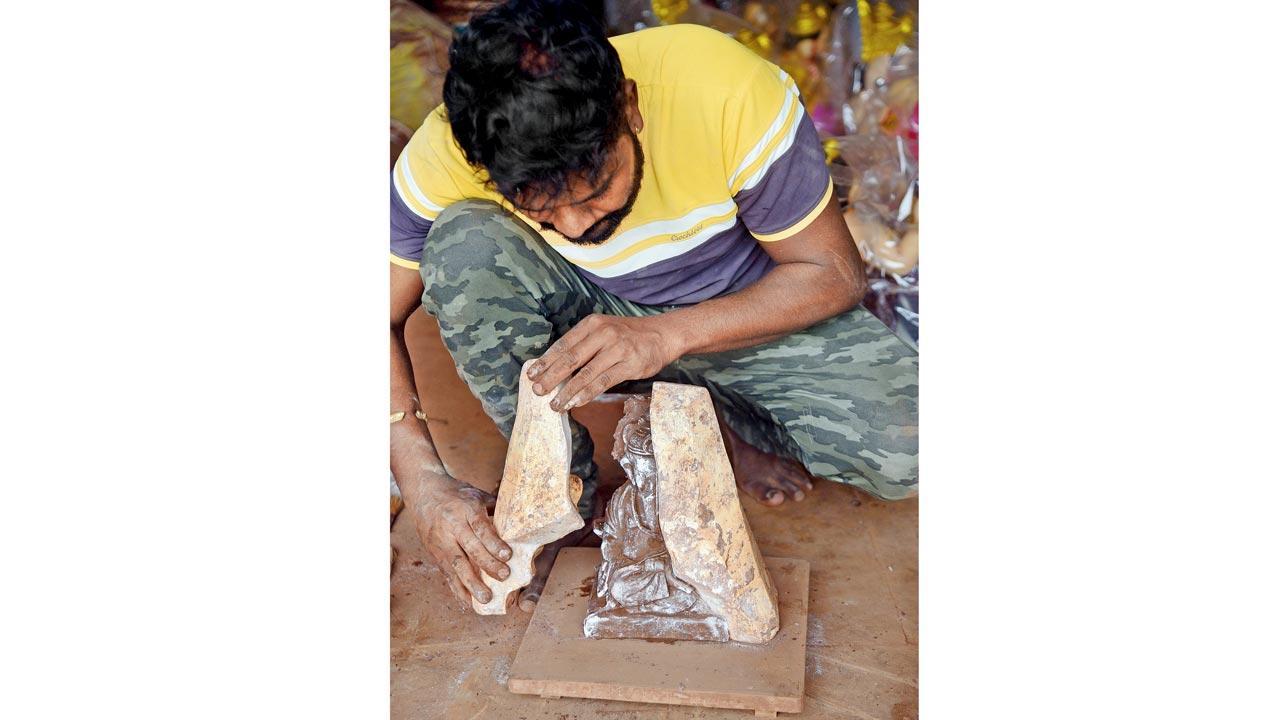
A karigar cracks open the mould to reveal a maati idol at a workshop in Uruli Kanchan, near Pune, run by Kedar Kumbhar and Dr Akshay Kauthale. The idols here are made from nothing else but farm soil and water. Pic/Pradeep Dhivar
The road towards Uruli Kanchan, around 30 km from the city of Pune, is lined with a row of nurseries—mostly of all kinds, but prominently roses in reds, yellows and pinks. The village has a Gandhian legacy, having birthed the naturopathy centre, Nisargopchar Ashram, established by Mahatma Gandhi in 1946; it draws from the five elements of nature to offer therapies for everything from skin, respiratory, to gastrointestinal, cardiovascular and endocrine disorders. A more famous offshoot is the BAIF Development Research Foundation, renowned for its pioneering research in agricultural development and whose late founder Manibhai Desai—who also steered work at the ashram—was deeply influenced by Gandhi’s holistic and sustainable solution for self-employment.
ADVERTISEMENT
Nature flows in the veins of Uruli Kanchan.
It’s hardly surprising then that a new movement for eco-friendly Ganeshas has taken root here.
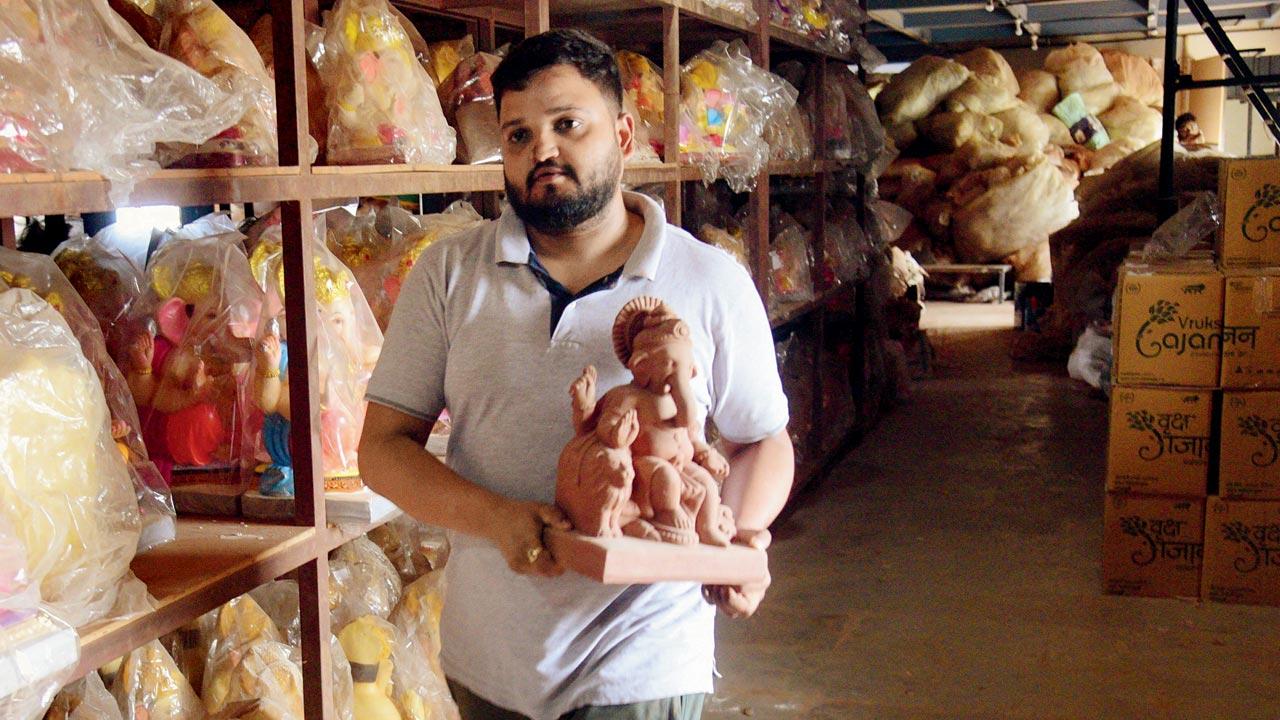 Kedar Sunil Kumbhar
Kedar Sunil Kumbhar
When we reach Uruli Ashtapur Road after a five-and-a-half hours drive from Mumbai, we are reminded of Hamrapur in the Pen taluka of Raigad district that we had visited around the same time last year. On either side of the road are open shops where half-finished Plaster of Paris (PoP) Ganesh idols stand in file. At the workshops behind, karigars are busy at work, giving final touches to the idols that will be delivered to neighbouring cities in Maharashtra. In the business of idol-making, Uruli Kanchan is a fledgling. With 450-plus workshops, Hamrapur supports 15,000-odd karigars all under the umbrella of a formalised association. Here, there are barely 10 to 12 karkhanas, and a few hundred men and women employed on payroll. “There was a time when we all worked together during the idol-making season,” Kedar Sunil Kumbhar, 30, tells mid-day. “At some point, everybody separated and started their own businesses.”
Kedar belongs to the Kumbhar community of potters; his grandfather Dattatrey made both, decorative and utilitarian pottery, and bricks using red clay, before Kedar’s father Sunil Kumbhar decided to deviate from the traditional practice to work with shaadu maati and PoP idols. Shaadu is a type of natural clay with high elasticity found in Gujarat, Rajasthan and the Konkan region. It’s silt that comes from the rivers and settles in the creek.
Growing up in Uruli Kanchan, where conversation about conservation of nature took centre-stage, Kedar, who studied engineering, felt the desire to engage in a business that promised a greener future. PoP was anything but that. Plaster of Paris is a quick-setting gypsum plaster of hydrated calcium sulphate. It’s harmful to the environment because it is not water-soluble.
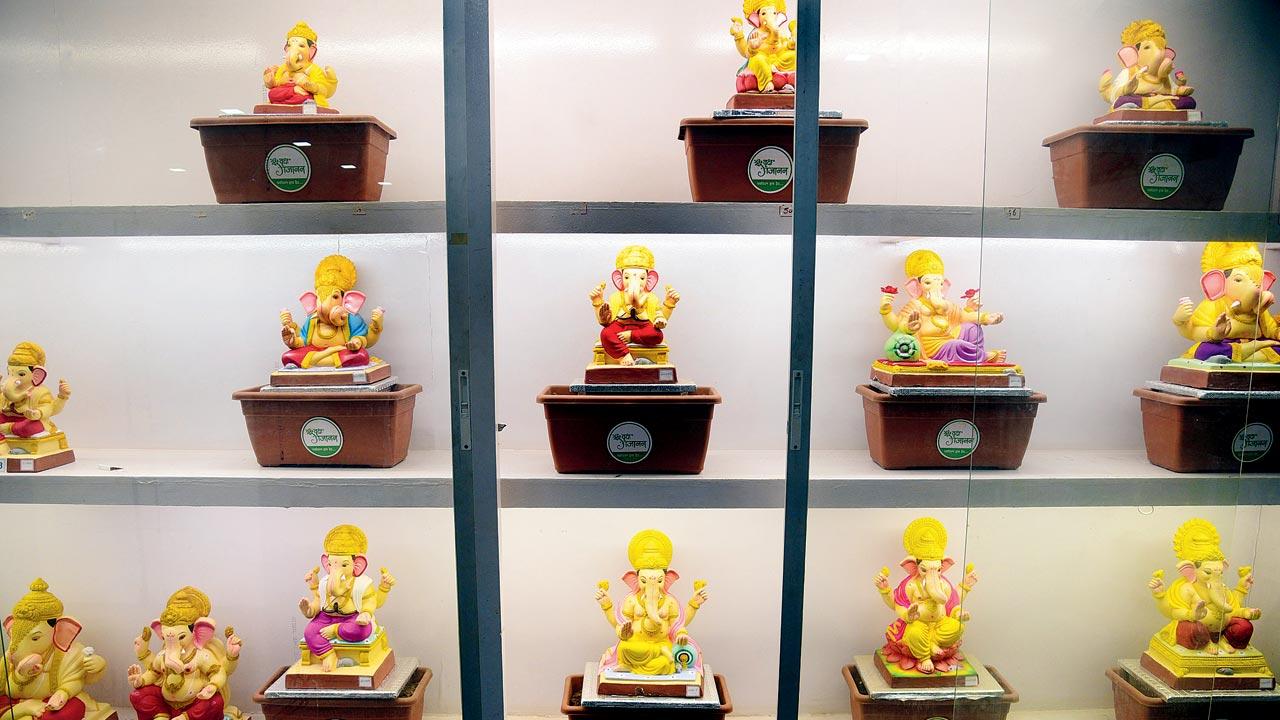 The Ganesh idol is sold with a pot, and tulsi seeds, so that once it is immersed, the same soil can be used to grow the plant. With many of the old customers already have tulsi growing aplenty from previous idols, they have now started distributing brinjal seeds as well
The Ganesh idol is sold with a pot, and tulsi seeds, so that once it is immersed, the same soil can be used to grow the plant. With many of the old customers already have tulsi growing aplenty from previous idols, they have now started distributing brinjal seeds as well
Conscious of this, Kedar brainstormed with his childhood friend, Dr Akshay Vitthal Kauthale, who is currently working at Sahyadri Hospital in Pune. “While growing up,” says 27-year-old Akshay, “I would see the harm we were inflicting on the environment by immersing PoP idols in the sea. This became quite rampant in the 1990s.” Having been raised in the BAIF campus where his father worked, he too became invested in the idea of creating a sustainable future.
In 2019, after years of research and development, the duo launched their green startup Vruksha Gajanan, which makes Ganpati idols with organic farm soil and water. In the short span of four years, demand they say, has grown manifold, with Vruksha Gajanan being distributed across several Indian metros, as well as Dubai, Australia, Germany and the US.
While shaadu maati is known to be an environmentally-friendly option, its chances of breakage are close to 40 per cent, preventing many idol makers from making the switch, despite the looming ban on using PoP.

In May 2020, during the lockdown, the Central Pollution Control Board had issued comprehensive guidelines for idol immersion, banning PoP idols, and the use of thermocol and plastic completely. Successive governments, first the Maha Vikas Aghadi and later, the Eknath Shinde-Devendra Fadnavis combine, postponed imposing the ban. Last year, the Brihanmumbai Municipal Corporation, in its attempt to make the transition smoother for PoP idol-makers, had stated that it would ban immersion of such idols the following year. But, while Ganesh Chaturthi is about a month away (September 19-28), no clear ruling has come out yet. Instead, the civic body has announced establishment of a special squad to monitor use of PoP Ganesh idols, with two officials assigned to each ward in Mumbai, and decided to provide 150-tonne of shaadu maati to sculptors free of cost. In response to a request from Ganesh mandals, the BMC has said it will fully implement the ban on PoP idols only next year.
Kedar and Akshay’s eco-friendly maati idols, they say, are sturdier and resilient to wear and tear. “While shaadu maati idols can be immersed at home, the silt accumulated has to be dumped into a water body or into the earth. If you immerse a mud idol like ours, the residue can later be used to grow plants. This circularity ensures zero waste,” says Kedar. Working with mud, however, requires time and patience.
It was COVID-19 that necessitated the shift to making maati idols. During the first year of the lockdown, when public immersions were discouraged, Ganesh Chaturthi celebrations were mostly confined to the homes. Kedar and Akshay realised the sudden need to scale up their passion project, so that people didn’t have to worry about going out to immerse the idols. When they started in 2019, they had sold just 200-odd mud idols, but in the pandemic, with time on their hands, they began experimenting more.
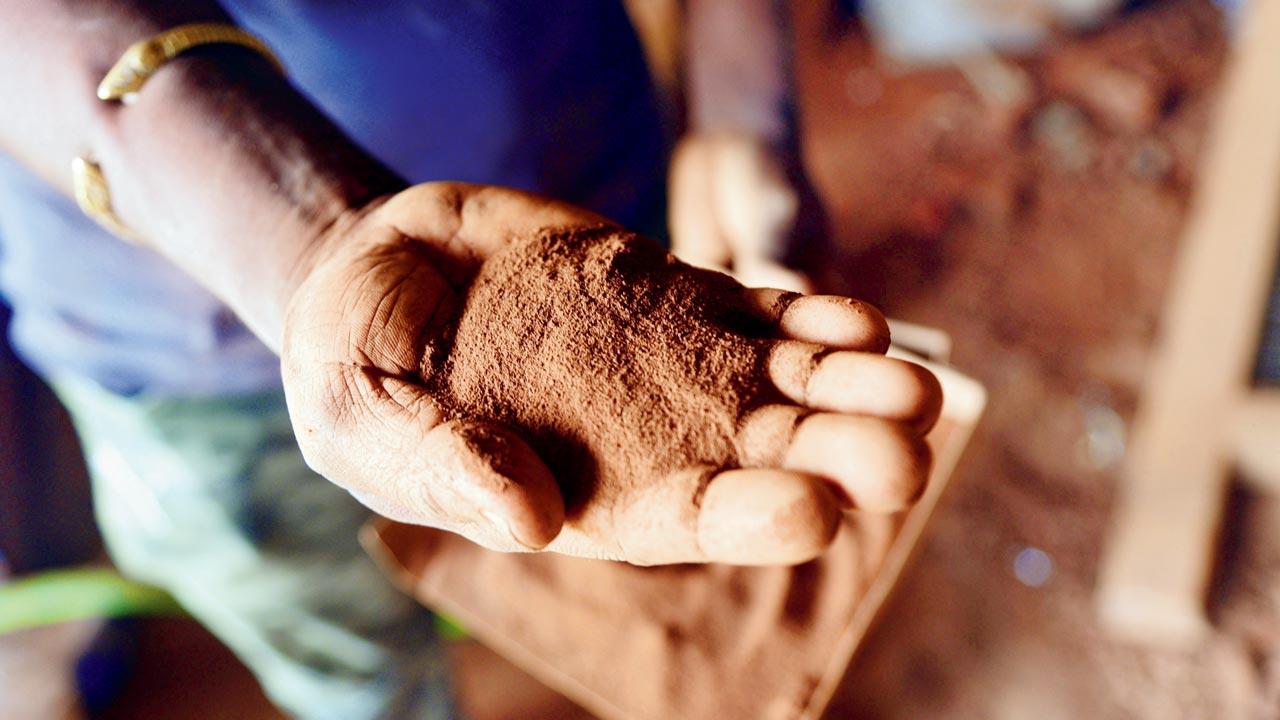 A worker at Vruksha Gajanan’s karkhana seen sieving farm soil, after stones and other dry waste are extracted from it. The soil is sieved at least thrice, before it is pulverised to create a fine, powder form. The soft soil that is procured is then mixed with water, and left for maturation. This can take at least 20 to 25 days, because each and every particle of the soil needs to be drenched completely. The mitti that is procured by the end of this laborious process has the texture of clay, and can be moulded into any form. Pics/Pradeep Dhivar
A worker at Vruksha Gajanan’s karkhana seen sieving farm soil, after stones and other dry waste are extracted from it. The soil is sieved at least thrice, before it is pulverised to create a fine, powder form. The soft soil that is procured is then mixed with water, and left for maturation. This can take at least 20 to 25 days, because each and every particle of the soil needs to be drenched completely. The mitti that is procured by the end of this laborious process has the texture of clay, and can be moulded into any form. Pics/Pradeep Dhivar
“My family understands the ecology of soil because three generations have been involved in it,” says Kedar, “But, while we knew how to handle mitti, what we didn’t know was how to make it durable.”
Kedar remembers turning to his grandmother, who had worked in their ancestral bhatti, firing and baking earthen pots. She shared her knowledge about the nature of soil, its maturity, and how fine it needs to be, so that it can be kneaded to create mud dough. Akshay’s father Dr Vitthal Kauthale, an agricultural scientist with BAIF, provided the technical know-how.
The team began with research and development, finding out which soil would work best. They also got two geologists, who were common friends, to weigh in. Black and red soil from the Konkan region were most preferred. “Soil that is used for growing rice, and gives the crop its starchiness lends itself perfectly for idol-making,” shares Kedar, adding, “We also source soil from land developers, in and around the region.”
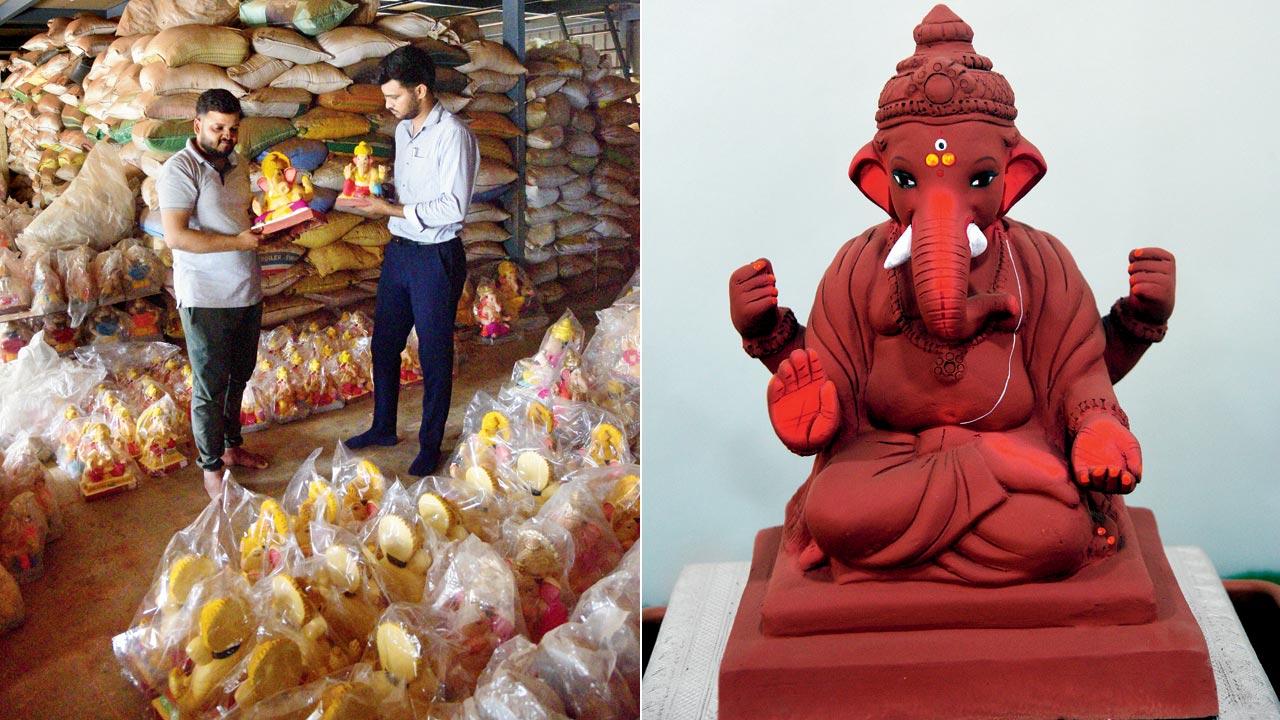 Childhood friends Kedar Sunil Kumbhar and Dr Akshay Vitthal Kauthale, who grew up in an environment where conservation of nature took centre-stage, launched Vruksha Gajanan in 2019. Their idols are distributed across several Indian metros, as well as Dubai, Australia, Germany and the US; (right) The mud idols are painted using natural dyes, yellow turmeric and kumkum, multani mitti, geru (red soil), which are mixed with tree gum. It is varnished with liquid obtained after soaking okra pods in water
Childhood friends Kedar Sunil Kumbhar and Dr Akshay Vitthal Kauthale, who grew up in an environment where conservation of nature took centre-stage, launched Vruksha Gajanan in 2019. Their idols are distributed across several Indian metros, as well as Dubai, Australia, Germany and the US; (right) The mud idols are painted using natural dyes, yellow turmeric and kumkum, multani mitti, geru (red soil), which are mixed with tree gum. It is varnished with liquid obtained after soaking okra pods in water
The soil has to be cleaned; stones or any other dry waste are extracted from it. “After that, it has to be sun-dried, and then sieved. We have to sieve it at least three times,” says Kedar, before it is pulverised to create a fine, powder form. The soft soil that is procured is then mixed with water—this process, he says, is called pugging. “The soil is then left for maturation. This can take at least 20 to 25 days, because each and every particle of the soil needs to be drenched completely.” The mitti that is procured by the end of this laborious process, which lasts over a month, has the texture of clay. “This is like gold for us... it can take any shape or form.”
The clay is hand-pressed into the PoP moulds using corn starch powder, so that it doesn’t stick. mid-day was given a short demo, and the entire process took barely seven to eight minutes. “We have separate moulds for the hands of the idols, which are crafted and attached to the body, to avoid any breakage.”
But unlike PoP, which is easy to work with and mould into any intricate shape which is why it’s also used in dentistry, dries quickly and is very strong when hardened, mud needs to be carved for finer details. In the final process, the artisans carve and sculpt the facial features, fine-tuning other elements, including the jewellery and the dhoti. The idol is once again dried in a controlled environment. “We have to be very particular about this process—you cannot expose it to excessive heat or air,” says Kedar, explaining, “If the harsh rays of the sun fall on a wet ground, it develops cracks. Something similar happens in this case too.”
Once it is completely dried, the idol is then painted using natural dyes, yellow turmeric and kumkum, multani mitti, geru (red soil), which are mixed with tree gum. The idol is varnished with liquid obtained after soaking okra pods in water.
The Ganesh idol is sold with a pot, and tulsi seeds, so that once it is immersed, the same soil can be used to grow the plant. “As many of our old customers already have tulsi growing aplenty from previous idols, we now give them brinjal seeds,” shares Kedar.
The team has over 20 karigars, mostly women from the village, working for them. Work on preparing the soil for the next year begins right after Ganesh Chaturthi. The winter sun, says Kedar, which is not too harsh, is perfect for the drying process. Based on the bulk orders, Ganpati idols are moulded, shaped, and painted until May. “We don’t work during the monsoon, because the condition is not favourable to work with mud.” At present, they are busy dispatching their orders, and this will continue till before the festival season begins. International orders are sent as early as February. Annually, over 12,000 Vruksha Gajanans are sold across India and abroad, through their dealers.
When not at the hospital, Akshay who has to travel nearly 30 km to get to the workshop, spends his time in Uruli Kanchan. While he handles the marketing, they have a packaging, sales, and social media team doing the rest of the work. Kedar is focussed on production. “It’s a well-oiled machine,” says Akshay.
Kedar claims that their product is not easily breakable. “But if it comes in contact with water, it can quickly fall apart,” he admits.
In June last year, Vruksha Gajanan received an ISO Certification. While funding for the project was hard to come by, the startup received support from the Pradhan Mantri MUDRA Yojana (PMMY), a scheme launched by Prime Minister Narendra Modi on April 8, 2015 for providing loans up to R10 lakh to the non-corporate, non-farm small/micro enterprises. Prakash Javadekar, former Minister of Environment Forest and Climate Change inaugurated the project. Ever since, the state government has been putting their weight behind the startup, with Deputy CM Devendra Fadnavis and veteran BJP leader Nitin Gadkari and NCP chief Sharad Pawar, extending their support to the outfit.
While they have restricted their idol sizes to 14 and 16 inches, the hope, says Akshay, is to create larger-sized idols for sarvajanik or public celebrations, so that the transition is smoother for those opting for PoP idols. “It is easily doable, but it will require some will and also support from the government and other authorities,” says Akshay. According to him, protecting the environment is the future. “We should celebrate, but without disrupting the ecological balance.”
“Our family has returned to working with soil after two generations,” says Kedar. “We had no practical knowledge, so we had to learn and unlearn a lot of things. But each time we see a Ganesh idol evolve into a tulsi plant, we feel like we are doing something right.”
60-90
Time in minutes it takes Vruksha Gajanan to dissolve in room temperature water
1.93L
No. of idols immersed in Mumbai in 2022 during the 10-day Ganesh festival
 Subscribe today by clicking the link and stay updated with the latest news!" Click here!
Subscribe today by clicking the link and stay updated with the latest news!" Click here!







